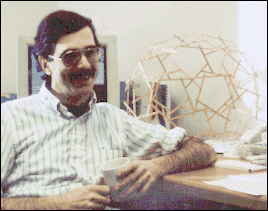The Pavilion of Polyhedreality
I welcome you to peek into my personal pavilion of practical polyhedra.
All images are copyright by George W. Hart.
This figure shows me and a tensegrity structure made from coffee
stirrers
and dacron thread. No two sticks actually touch each other.
Note: For your maximal synesthetic enjoyment, I have
chosen
short musical selections to go with each picture. If your web viewer is
set
up to play MIDI music files, just click on any of the red notes
before
selecting a picture, and you can listen to a J.S. Bach piece as
background
music while each image is transferring.
The following images are available at the moment:
- Nailbanger's Nightmare A simple project
for
all
you weekend carpenters. Get out those old two-by-four scraps you have
been
saving.
 [185K]
[185K]
- Paper Ball Paper constructions of
this
sort
are amazingly light and strong. There are lots of examples in
Wenninger's
book Spherical Models, listed below. This one is made of 3120
curved
arcs. Geodesic buffs will notice the lack of alignment along the 5-fold
axes of symmetry.
 [82K]
[82K]
- Puzzle The first part of the puzzle
is
to figure
out the name of the underlying polyhedron, comprising 12 pentagons and
60 hexagons.
 [250K]
[250K]
- If you build it, he will come... If
you
are
like me, you like to make things out of paper clips. But the snub
dodecahedron
is a relatively tough one, though not impossible. At each vertex, one
pentagon
and four equilateral triangles meet.
 [104K]
[104K]
- Selected Recent Publications This may
be
a reaction
to unpleasant academic experiences.
 [179K]
[179K]
- Apples and Oranges If you like to
play
with
your food and silverware, I am sure you make little dinner-time
sculptures
as I do. Here, sixty forks, arranged along the edges of a rhombic
triacontahedron,
bind 12 apples (placed at the corners of an icosahedron) and 20 oranges
(placed at the corners of a dodecahedron).
 [243K]
[243K]
- Artificial Radiolarian Reticulum
Radiolarians
are microscopic ocean-living protozoa with complex
geodesicly-perforated
silica skeletons and sharp spicules. Drawings of a great variety of
Radiolaria
skeletons by the 19th century naturalist Ernst Haeckel can be found in
many books that deal with geometry, symmetry, and nature. This image
attempts
to capture the idea of a radiolarian and is not faithful to any
particular
species.
 [214K]
[214K]
The above figures were each ray traced with POV-ray,
using data files produced by a polyhedral construction program I wrote
which creates a wide variety of objects with icosadodecahedral
symmetry.
The program is described in this
paper.
- Stained Glass Ball This is
just a
concept
(not raytraced) based on the zonohedrification of the rhombic
enneacontahedron.
Exactly 1230 pieces of glass are required. [47K]
--- Virtual Reality Polyhedra ---
To learn more than you ever wanted to know about polyhedra, you will
want
to visit my Encyclopedia of
Polyhedra.
It is intended as a museum of objects, a reference work, and a tutorial
of sorts, all dedicated to the serene, timeless beauty of polyhedra and
their interrelationships. Over 1000 polyhedra are on display here ---
from
the familiar to the never-before-seen --- far more than have ever been
assembled or collected anywhere. All are truly three-dimensional,
meaning
you can rotate them and move them around on your computer screen. I
plan
to complete and publish the Encyclopedia someday as a combination book
and CD ROM. In the meantime, you are welcome to take a look as I write
each new section.
Other Sites...
 Here
are a few other web pages related to polyhedral and/or geodesic stuff:
Here are some interesting and/or popular illustrated references on
polyhedra.
For a substantial annotated bibliography, see the annotated
bibliography of references in Virtual
Polyhedra.
Here
are a few other web pages related to polyhedral and/or geodesic stuff:
Here are some interesting and/or popular illustrated references on
polyhedra.
For a substantial annotated bibliography, see the annotated
bibliography of references in Virtual
Polyhedra.
- George W. Hart and Henri
Picciotto, Hands-on
Geometry with the Zome System, Key Curriculum Press.
- Anything by H.S.M. Coxeter.
- Peter R. Cromwell, Polyhedra, Cambridge, 1997.
- H. Martyn Cundy and A.P. Rollett, Mathematical Models,
Oxford,
1961.
- Alan Holden, Shapes, Spaces and Symmetry, Columbia Univ.
Pr,
1971.
- Peter Pearce, Structure in Nature is a Strategy for Design,
MIT,
1978.
- Anthony Pugh, Polyhedra: A Visual Approach, U. Cal. pr.,
1976.
- Marjorie Senechal and George Fleck (eds.), Shaping Space: A
Polyhedral
Approach, Birkhauser, 1988.
- Magnus J. Wenninger, Polyhedron Models, Cambridge, 1971.
- Tarquin Books of polyhedra models
In addition, though it is not directly related to polyhedra, if you are
interested in applied mathematics and linear algebra, you will of
course
want to check out my book,  Multidimensional
Analysis.
Multidimensional
Analysis. 

Comments by email to george@georgehart.com
are welcome. 
And for those of you who are wondering: Yes, "Polyhedreality" is a
hapax
legomenon. 

![]()
![]()